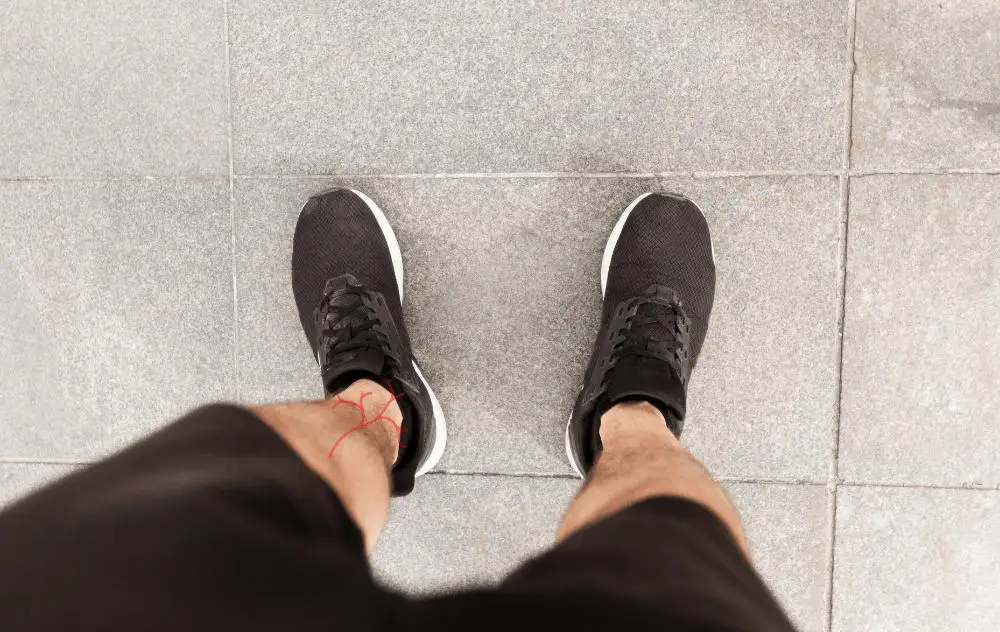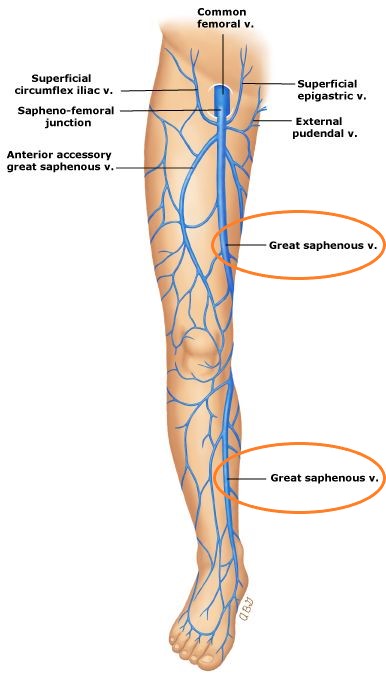
Your body’s circulatory system is made up of the heart, the lungs, and three types of blood vessels: arteries, veins, and capillaries. Arteries carry oxygen-rich blood from your heart to your body’s organs and tissues. Veins carry oxygen-depleted blood and waste products back to your heart, using one-way valves to help keep blood flowing toward the heart. Capillaries are the smallest blood vessels: they connect small arteries and small veins.
Major veins and arteries are named either after the region of the body they carry blood through or for nearby structures. The great saphenous, iliac, femoral, posterior tibial, and renal veins are all vital parts of the circulatory system. The great saphenous vein (GSV) is the longest vein in the body. It’s also the most likely to be impacted by vein disease. Below, we discuss the great saphenous vein’s function as an important part of a healthy circulatory system.
If you have additional questions about your veins or vein health, we recommend consulting a vein specialist.
Where is the Great Saphenous Vein?
The great saphenous vein gets its name from a word meaning “concealed”, because it runs the length of your leg from your foot to your thigh, and connects to the deep femoral vein near your groin. If you look down at the inside of your leg, the circular bone that sticks out at your ankle is where you can see your great saphenous vein. The great saphenous vein is a superficial vein, meaning that its job is to carry blood from the tissues near the skin’s surface in your feet and legs to the deep veins.
Conditions Associated with the Great Saphenous Vein
Since it is the longest vein in the body, the great saphenous vein is most likely to be impacted by vein disease. Each year, approximately 150,000 new patients are diagnosed with chronic venous insufficiency. This common health condition is the underlying cause of varicose veins and spider veins, which occur when vein valves are damaged and cannot properly circulate blood back to the heart. The GSV has at least six valves, and because it’s located in your lower extremities, it has to work against gravity to pump blood back to your heart, making it more vulnerable to damage or pressure.
Another vein that is commonly impacted by vein disease is the small saphenous vein, which runs under the skin from the outside of the foot to the back of the calf, ending at the knee.
It is the second most likely vein to be treated for symptoms related to venous insufficiency because it also has a lot of valves and works against gravity.
When left untreated, vein disease can cause a range of painful symptoms, along with leading to dangerous health issues like blood clots and venous ulcers. Symptoms of vein disease include leg swelling, cramping, heaviness, itchiness, and fatigue. Venous symptoms can range from mild to severe, often impacting quality of life. As vein disease progresses, you may experience skin changes and ulceration near visible veins.
If you have vein disease, you may be at increased risk for developing a blood clot in the great saphenous vein (greater saphenous vein thrombosis) or within the deep venous system (deep vein thrombosis or DVT). Blood clots can lead to a life-threatening condition known as embolism in other organs such as the lungs (pulmonary embolism) or the brain, which may cause a stroke.
SIGNUP FOR MORE HEALTH NEWS & UPDATES
Treatment for Vein Disease in The Great Saphenous Vein
With advances in medical technology, there are non-surgical treatments that can relieve symptoms and help prevent vein disease from progressing into DVT or other serious conditions. At USA Vein Clinics, our minimally invasive procedures offer a range of techniques to treat diseased veins and improve patients’ quality of life. Our Varithena treatment uses foam to treat vein conditions associated with the great saphenous vein and its surrounding veins.
A 2016 study published in Phlebology found that Varithena was effective at relieving symptoms of vein disease,
including improving the appearance of varicose veins. Varithena is an outpatient procedure that can be performed in under 30 minutes, depending on how many veins need to be treated. After Varithena, you’ll be able to immediately return to home or work: there is no need to take time off or plan for an extended recovery.
MORE QUESTIONS? TALK TO A VEIN SPECIALIST TODAY
Schedule an Appointment at USA Vein Clinics
Whether you have general questions about vein health or want to learn about other minimally invasive treatment options for the great saphenous vein, we are here for you. At USA Vein Clinics, our team of experienced vein specialists is available to develop a treatment plan specifically for you.
We offer over 100 state-of-the-art treatment clinics across 18 states, along with convenient telemedicine consultations.
Our vein treatments are covered by most major insurance plans. To ask about your coverage or schedule a consultation, give us a call at 888.768.3467.
Medically Reviewed by Dr. Yan Katsnelson, M.D.
Dr. Yan Katsnelson is the founder and CEO of USA Vein Clinics. Dr. Katsnelson is a highly skilled cardiac surgeon who completed a fellowship at the Brigham and Women’s Hospital, Harvard School of Medicine, in Boston, MA. His clinical area of expertise includes minimally invasive procedures to treat vein and vascular diseases. Dr. Katsnelson has established himself as a strong advocate for accessible, affordable, and compassionate healthcare services.

